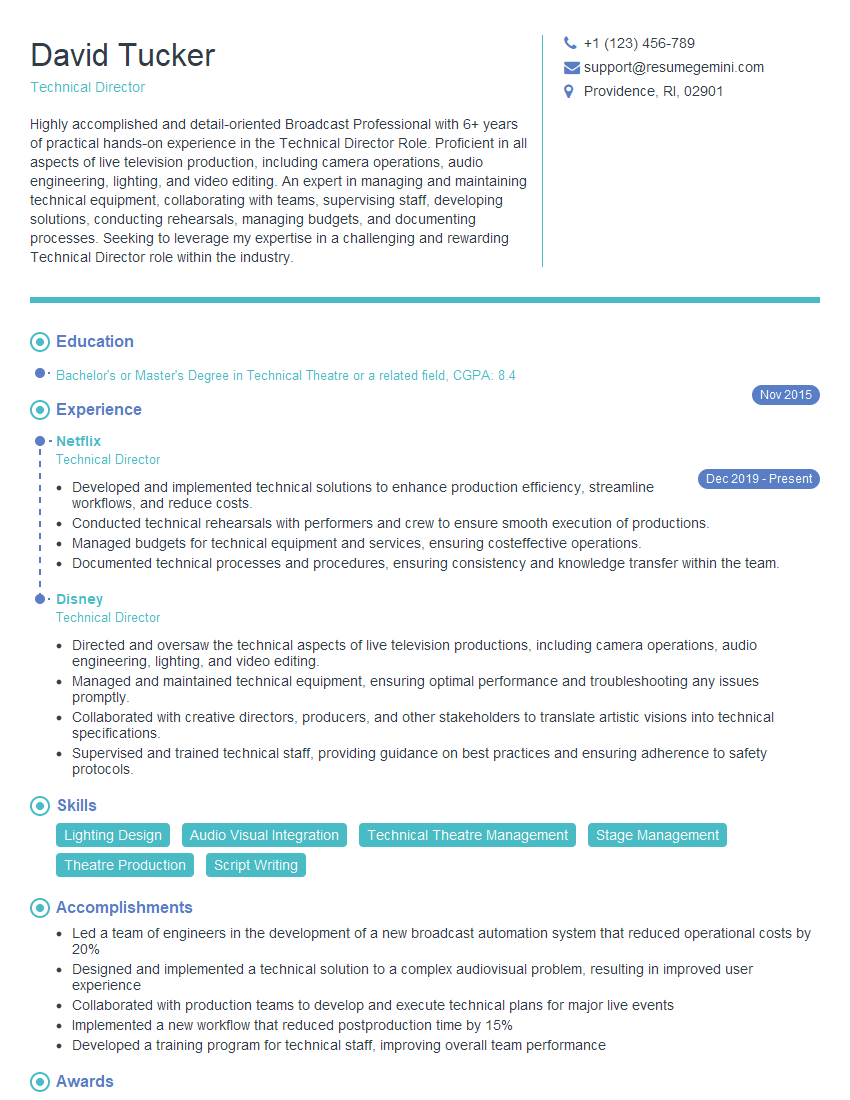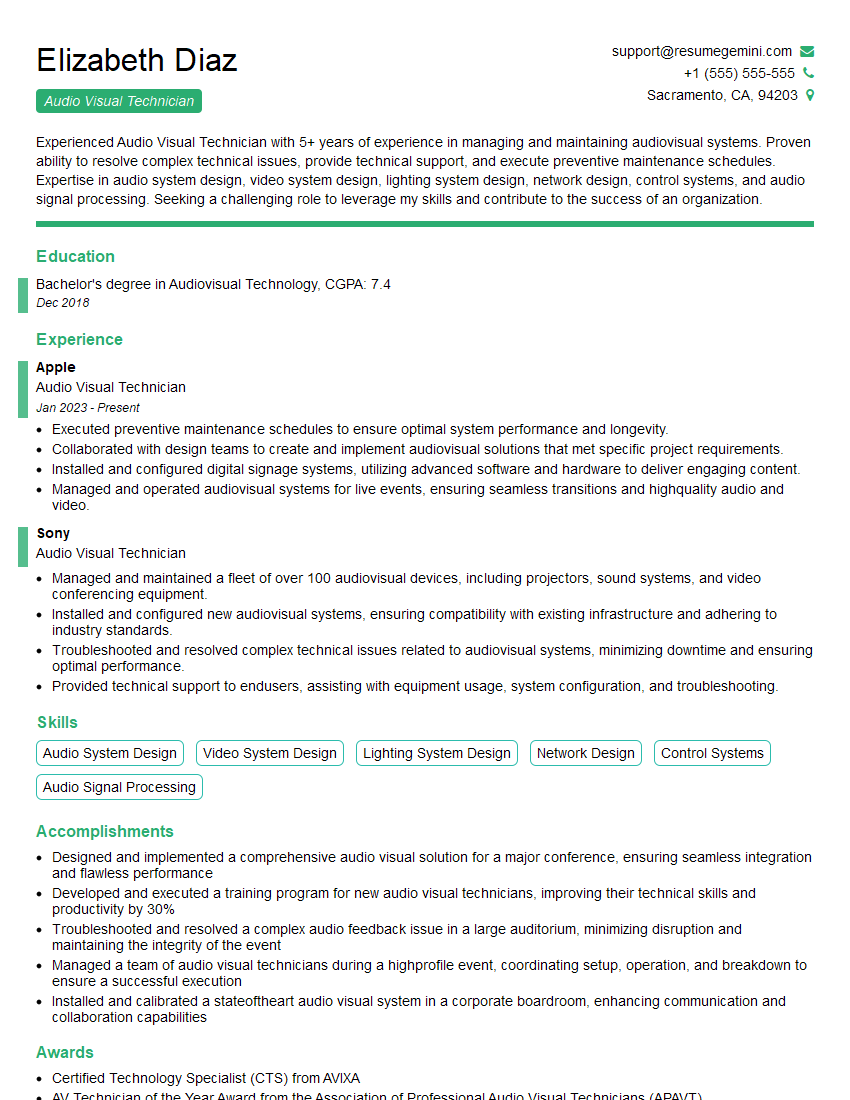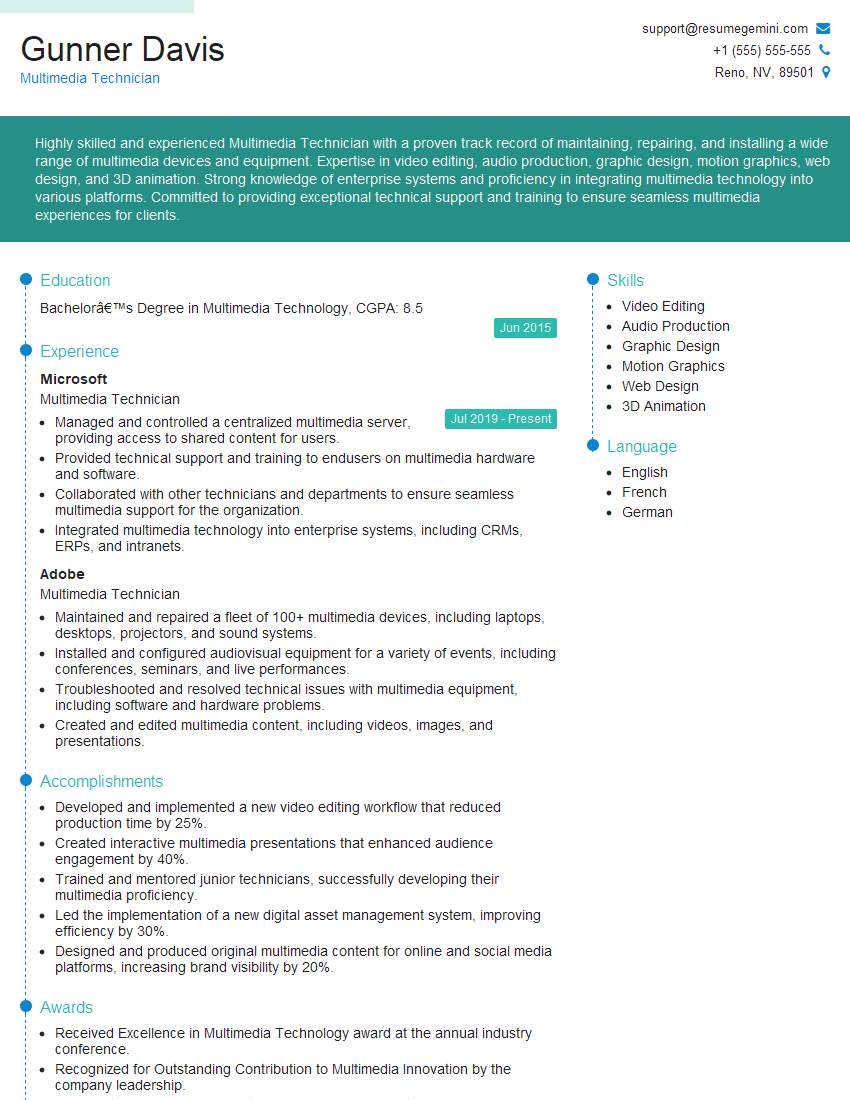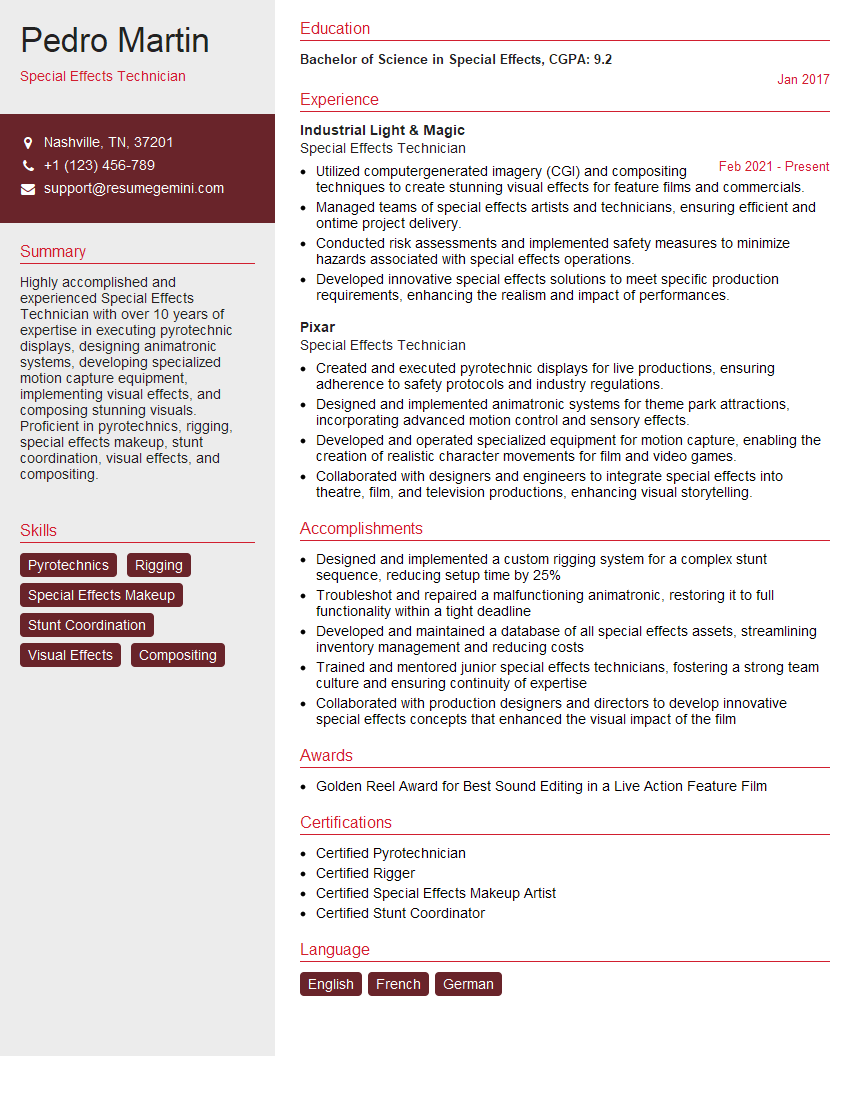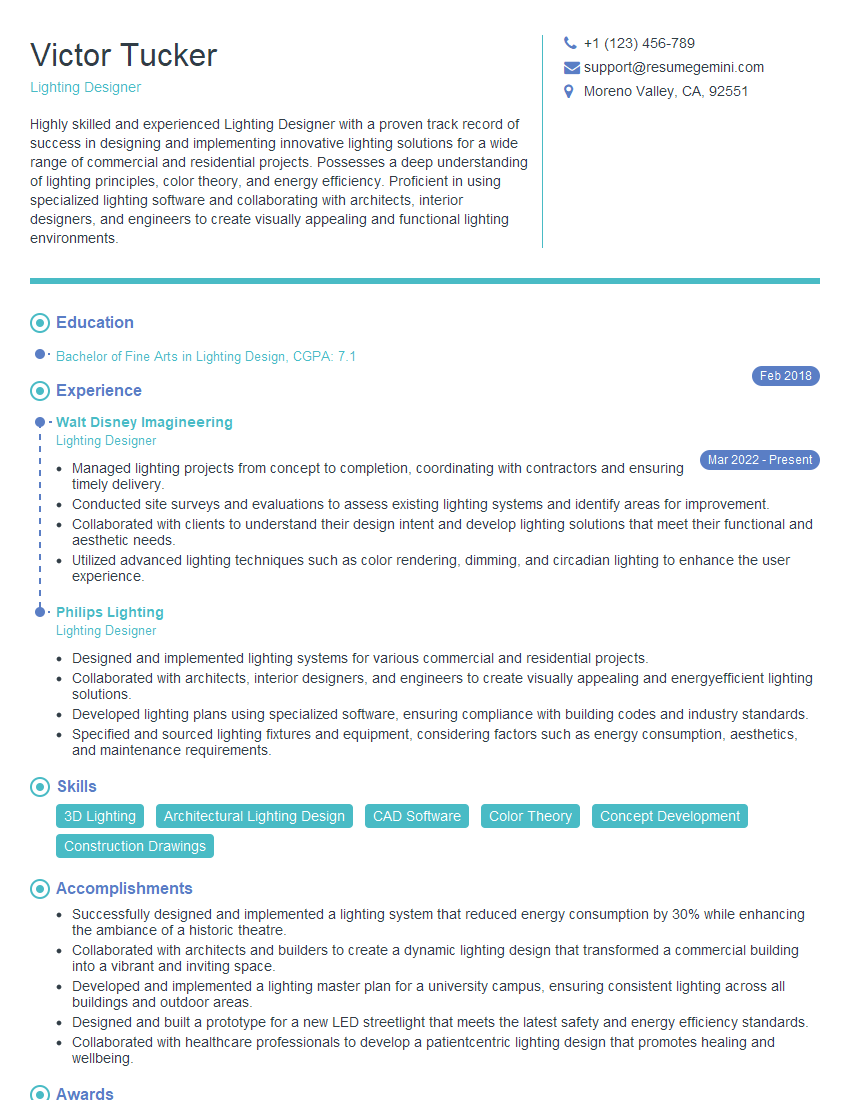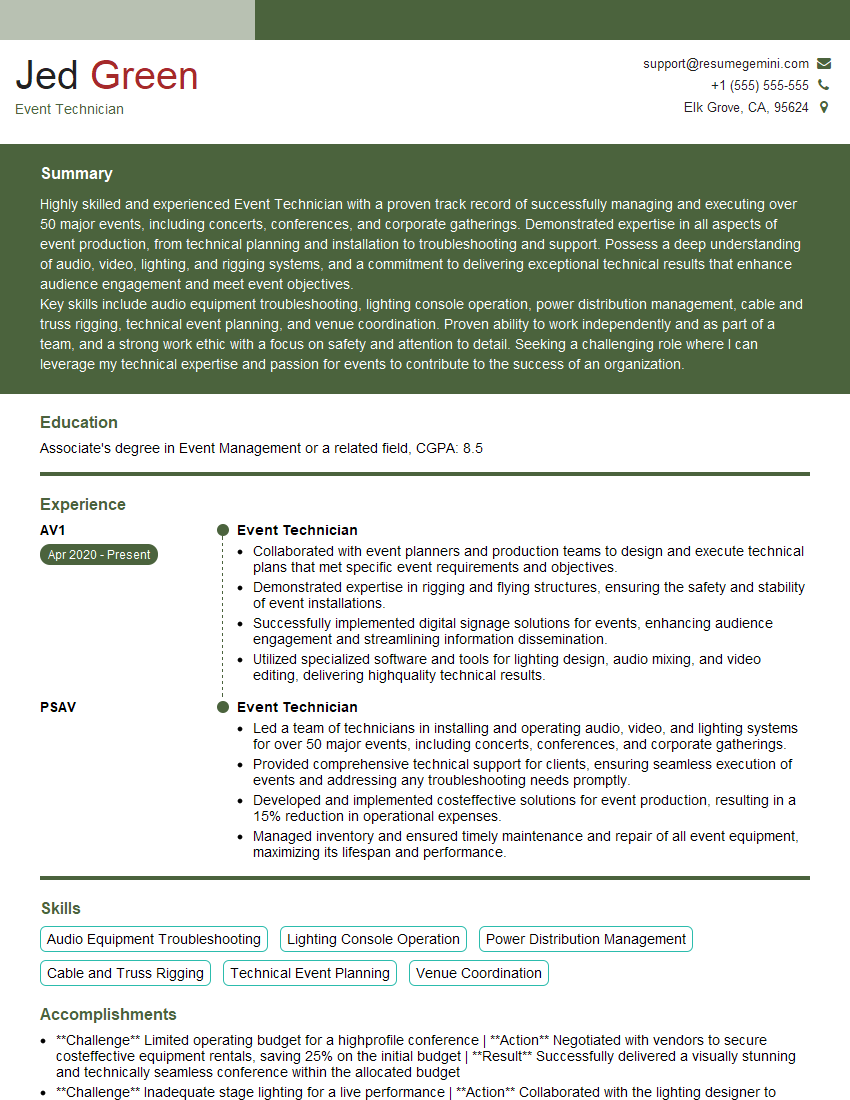The thought of an interview can be nerve-wracking, but the right preparation can make all the difference. Explore this comprehensive guide to Uplighting interview questions and gain the confidence you need to showcase your abilities and secure the role.
Questions Asked in Uplighting Interview
Q 1. What types of uplighting fixtures are you familiar with?
I’m familiar with a wide range of uplighting fixtures, categorized primarily by their light source and mounting method. Common types include:
- LED Uplights: These are the most prevalent due to their energy efficiency, long lifespan, and vibrant color options. They come in various forms, such as PAR cans, cylindrical units, and even small puck lights that can be easily hidden.
- Tungsten-Halogen Uplights: While less common now due to higher energy consumption and shorter bulb life, they offer a warmer, more traditional light output. They were frequently used in the past for their rich color rendering but are slowly being phased out in favor of LED.
- Fiber Optic Uplights: These utilize fiber optic cables to transmit light from a central source to multiple points, allowing for highly flexible placement and unique illumination effects. They’re particularly useful in applications requiring a large number of individually controllable uplights, or where wiring is difficult.
- Architectural Uplights: These are often built-in fixtures designed as part of the building’s architecture, providing a more seamless and integrated lighting solution.
My experience encompasses both the design and implementation of each type, allowing me to tailor lighting solutions to the specific needs of every project.
Q 2. Explain the difference between LED and tungsten uplighting.
The main differences between LED and tungsten uplighting lie in energy efficiency, lifespan, color temperature, and cost.
- Energy Efficiency: LEDs are significantly more energy-efficient than tungsten-halogen bulbs. They produce more light with less power, leading to lower operating costs and reduced environmental impact.
- Lifespan: LED uplights have a much longer lifespan, typically lasting for tens of thousands of hours, compared to tungsten-halogen bulbs, which need frequent replacements. This reduces maintenance and replacement costs.
- Color Temperature: Tungsten bulbs produce a warm, yellowish light (around 2700K-3000K), while LEDs offer a much broader range of color temperatures, from very warm to cool daylight, allowing for greater creative control. LEDs also generally offer better color rendering (CRI), meaning colors appear more accurate and vibrant.
- Cost: While the initial cost of an LED uplight might be higher, the long-term savings in energy and maintenance often outweigh the upfront investment.
Imagine comparing a traditional incandescent light bulb to a modern LED – the LED uses far less electricity and lasts much longer. This analogy perfectly captures the differences between these two uplighting technologies.
Q 3. How do you calculate the number of uplights needed for a specific venue?
Calculating the number of uplights depends on several factors: the venue’s size, ceiling height, desired illumination level, and the uplight’s output (measured in lumens). I typically follow a systematic approach:
- Measure the space: Accurately determine the perimeter of the walls needing uplighting.
- Determine the desired intensity: A subtle wash of color might require fewer lights than a dramatically illuminated space. This is often a collaborative decision with the client, balancing aesthetic goals with budget limitations.
- Consider the uplight’s beam angle and throw distance: A narrower beam angle requires more fixtures to cover the same area, while a wider angle might be sufficient for larger venues.
- Use a lighting calculation software: Professional lighting design software can model the light distribution, helping optimize the number and placement of uplights to ensure even coverage.
- Factor in safety margins: It’s always advisable to have a few extra uplights on hand to account for potential failures or to allow for adjustments during the setup.
For example, a small ballroom might only require 12-16 uplights, while a large wedding hall could need 40 or more. The calculation is less about a fixed formula and more about a careful assessment of the space and lighting needs.
Q 4. Describe your experience with color mixing and temperature control in uplighting.
My experience with color mixing and temperature control in uplighting is extensive. Many modern LED uplights offer sophisticated control systems allowing for:
- Precise Color Mixing: Using RGB (Red, Green, Blue) or RGBW (adding White) LEDs, I can create virtually any color imaginable by adjusting the intensity of each color channel. This allows for dynamic lighting displays synchronized with music or events.
- Color Temperature Adjustment: I can control the warmth or coolness of the light by adjusting the color temperature (measured in Kelvin). This might involve shifting from a warm amber for a romantic ambiance to a cooler white for a more modern feel.
- Color Scrolling and Chasing: Many systems allow for programmed color sequences, adding dynamic visual interest.
Recently, I designed a lighting scheme for a corporate event where we used color temperature to highlight different aspects of the room. Warmer tones were used to create intimacy in the dining area, while cooler tones illuminated the presentation stage. This showcased my ability to utilize color as a powerful design tool.
Q 5. What are the safety considerations when installing uplighting fixtures?
Safety is paramount when installing uplighting fixtures. Key considerations include:
- Electrical Safety: All wiring must adhere to local electrical codes. Using certified electricians for installation is crucial, particularly in situations involving high power or outdoor settings. Proper grounding and circuit protection are essential.
- Fire Safety: Uplights should be placed away from flammable materials. Regular inspection of fixtures for any damage to wiring or overheating is also crucial.
- Stability and Secure Mounting: Uplights should be securely mounted to prevent accidental falls or damage. Using appropriate brackets and mounting hardware is essential. This is especially important for heavy tungsten fixtures.
- Accessibility: Ensure that fixtures are accessible for maintenance and replacement, without compromising safety. Avoid placing fixtures in high, hard-to-reach areas unless you have proper access equipment.
- Risk Assessment: Before undertaking any installation, a proper risk assessment should be conducted to identify and mitigate potential hazards. This may involve using personal protective equipment (PPE) or implementing other safety measures.
For instance, I always use GFCI (Ground Fault Circuit Interrupter) outlets when installing uplights outdoors to prevent electric shocks from water exposure.
Q 6. How do you address challenges with uneven lighting distribution?
Uneven lighting distribution is a common challenge in uplighting. Addressing this involves:
- Careful Fixture Placement: Strategic placement is critical. Often, this involves experimentation and fine-tuning during setup. It’s crucial to avoid placing lights too close together, leading to over-illumination in some areas and neglecting others.
- Adjusting Beam Angles: Many uplights allow for beam angle adjustment. This fine-tuning can help spread light more evenly.
- Using Multiple Fixtures with Overlapping Coverage: Instead of relying on single, powerful uplights, using multiple smaller units with overlapping beams can produce a more even illumination.
- Using Diffusers or Lenses: Attaching diffusers or lenses to the uplights can soften the light and reduce harsh shadows, contributing to a more even look.
- Light Meter Measurements: Using a light meter to measure illuminance levels at various points in the venue allows for precise adjustments to achieve uniform lighting.
In a recent project, we tackled uneven wall coverage by using a combination of strategically placed uplights with adjustable beam angles and some supplementary wall washers to supplement the uplighting in areas where the light was not distributed evenly.
Q 7. Explain your experience with different types of uplighting control systems.
My experience encompasses various uplighting control systems, including:
- DMX (Digital Multiplex): This is a professional standard for controlling stage and architectural lighting. It allows for precise control of individual uplights, enabling complex color mixing, dimming, and dynamic effects.
- Wireless DMX Systems: These offer the flexibility of wireless control, eliminating the need for extensive cabling. They are particularly useful in large venues or where cabling is impractical.
- Standalone Controllers: Simpler uplights might use built-in controllers or handheld remotes for basic on/off, dimming, and color selection. These are useful for smaller events or installations requiring less complex control.
- Networked Control Systems: Some higher-end systems utilize network protocols like Art-Net or sACN for centralized control of numerous fixtures. This is ideal for very large-scale installations.
- Smartphone/Tablet Apps: Many modern LED uplights offer control via dedicated smartphone or tablet apps, providing intuitive interfaces for adjusting settings remotely.
The choice of control system depends heavily on the complexity of the lighting design and the budget. For instance, a simple event with only a few uplights might only need a standalone controller, while a large concert might require a sophisticated DMX system with a dedicated lighting console.
Q 8. How do you troubleshoot common uplighting issues?
Troubleshooting uplighting issues often involves a systematic approach. I start by visually inspecting each fixture, checking for loose connections, damaged cables, or blown bulbs. A simple power cycle can often resolve minor glitches. If the problem persists, I’ll check the power source – ensuring sufficient amperage and proper voltage. DMX control systems require a check of the signal path, looking for signal drops or incorrect addressing. I also utilize a DMX tester to pinpoint faulty channels or connections. For LED uplights, I might check for heat buildup which can sometimes affect performance. If a fixture remains unresponsive after these checks, then replacement is necessary.
For instance, at a recent wedding reception, several uplights flickered intermittently. A quick inspection revealed a loose connection at the power distribution box. Tightening the connection immediately solved the issue. In another case, a faulty DMX address caused one zone to remain dark. Re-addressing the fixture in the programming software rectified the situation.
Q 9. What are the benefits of using DMX control for uplighting?
DMX (Digital Multiplex) control offers unparalleled flexibility and precision in managing uplighting. Unlike simpler on/off switches, DMX allows for individual control of each fixture, or groups of fixtures, providing fine-tuned adjustments to color, intensity, and even special effects. This enables dynamic lighting changes throughout an event, perfectly synchronised to music or other cues. The ability to program and store scenes is crucial for efficiency and consistency across multiple events.
For example, imagine a corporate event. Using DMX, we can seamlessly transition from a vibrant welcome reception scene to a more subdued ambiance for a keynote speech, and then a dynamic, energetic atmosphere for the networking event. This level of control is impossible with simple switches, significantly enhancing the overall event experience.
Q 10. Describe your experience with power distribution for uplighting systems.
Power distribution is critical for large-scale uplighting installations. My approach involves careful calculation of the total power draw of all fixtures to ensure I have appropriate circuits and breakers. I always prioritize the use of properly sized and protected power cables to prevent overheating and potential fire hazards. I utilize power distribution boxes to organize and manage the power supply to each fixture, allowing for a clean and safe installation. I always ensure adherence to local electrical codes and regulations.
In one project, we illuminated a large outdoor venue. I used a dedicated power distribution system with multiple circuits and breakers to manage the large number of uplights. This approach ensured the safety and reliable operation of the entire system. Proper planning of power distribution is essential to avoid overloading circuits, a potentially disastrous outcome.
Q 11. How do you create different lighting moods and atmospheres using uplighting?
Creating diverse moods and atmospheres with uplighting is achieved primarily through color manipulation and intensity control. Warm colors like amber and gold evoke feelings of comfort and intimacy, perfect for a romantic dinner. Cool colors like blues and purples create a more sophisticated and elegant atmosphere, suitable for corporate events. Bright, saturated colors inject energy and excitement into a party. Subtle variations in intensity can dramatically alter the mood, creating depth and visual interest. Careful consideration of color temperature, saturation, and intensity is crucial for achieving the desired effect.
For a recent wedding, we used warm white and amber uplights for the ceremony, transitioning to a vibrant mix of blues and purples for the reception, creating a smooth shift in ambiance as the event progressed. This gradual change amplified the emotional trajectory of the celebration.
Q 12. How do you ensure the uplighting complements the overall event design?
Ensuring uplighting complements the overall event design requires close collaboration with the event planner and designers. I begin by reviewing the event’s theme, color palette, and overall aesthetic. I then select fixtures and color schemes that enhance rather than compete with the existing design elements. Consideration of the venue’s architecture and features is also crucial; uplighting can highlight architectural details or mask less appealing aspects of the space. I aim to create a cohesive and harmonious visual experience.
For instance, a rustic-themed wedding might employ warm, earthy tones, while a modern art gallery opening might benefit from more minimalist, cool-toned lighting.
Q 13. What are your preferred methods for mounting uplighting fixtures?
My preferred mounting methods depend on the venue and the specific uplighting fixtures. Floor-standing fixtures are a versatile option, suitable for many spaces. For a more discreet setup, I often use wall-mounted brackets or clamps, ensuring fixtures are securely fastened and positioned for optimal effect. For temporary installations, I may use sandbags or weighted bases for stability. I prioritize safety and ensure fixtures are securely mounted to prevent accidents or damage.
In one event, we utilized floor-standing uplights in a ballroom. For another event in a historic building, we opted for carefully placed wall-mounted fixtures to avoid obstructing architectural features. Choosing the right method enhances both the aesthetic appeal and safety of the installation.
Q 14. Explain your experience with different types of uplighting gels and filters.
I have extensive experience using a variety of uplighting gels and filters, from standard color gels to more specialized effects filters like diffusion or CTO (Color Temperature Orange). Color gels allow for precise color control, providing a vast range of hues and shades. Diffusion filters soften the light, reducing harsh shadows and creating a more ambient glow. CTO filters adjust the color temperature, correcting for variations in light sources and achieving color consistency. Choosing the right gel or filter is essential for achieving the desired mood and color balance.
For instance, using a deep amber gel can add warmth and intimacy to a dimly lit space, whilst a light blue gel can enhance the cool tones of a modern setting. A diffusion filter can ensure smooth even lighting without harsh shadows, a vital aspect when highlighting artwork or creating a background wash of color.
Q 15. How do you manage cable management in an uplighting setup?
Effective cable management is crucial for a professional uplighting setup, ensuring safety, a clean aesthetic, and preventing tripping hazards. My approach is multifaceted:
- Pre-planning: I meticulously map out cable routes before installation, considering the event space’s layout, furniture placement, and access points. This involves using CAD software to create a visual representation and identify potential obstacles.
- Cable Concealment: I prioritize concealing cables wherever possible. This might involve running them along baseboards, under carpets (using appropriate cable protectors), or within wall cavities (when permitted and safe). For outdoor events, we use discreet cable trenches or camouflage techniques.
- Cable Ties and Management Systems: Neatly bundling cables with labeled cable ties is essential. For larger installations, I utilize dedicated cable management systems, including trays, conduits, and raceways, ensuring that cables are organized and easily accessible for maintenance.
- Power Distribution: Proper power distribution is key. I use power strips and surge protectors appropriately located and securely fastened, preventing overloading and ensuring power is evenly distributed across the uplighting fixtures.
- Post-Installation Inspection: A final thorough inspection is critical to identify any potential tripping hazards or loose connections before the event begins.
For example, at a recent wedding reception, we used a combination of baseboard concealment and strategically placed cable trays to manage over 50 uplighting fixtures, creating a flawless and safe environment.
Career Expert Tips:
- Ace those interviews! Prepare effectively by reviewing the Top 50 Most Common Interview Questions on ResumeGemini.
- Navigate your job search with confidence! Explore a wide range of Career Tips on ResumeGemini. Learn about common challenges and recommendations to overcome them.
- Craft the perfect resume! Master the Art of Resume Writing with ResumeGemini’s guide. Showcase your unique qualifications and achievements effectively.
- Don’t miss out on holiday savings! Build your dream resume with ResumeGemini’s ATS optimized templates.
Q 16. What are the advantages and disadvantages of using wireless uplighting?
Wireless uplighting offers significant advantages, but also comes with some drawbacks. Let’s explore both:
- Advantages:
- Flexibility: Wireless systems offer unparalleled flexibility in placement. Fixtures can be positioned anywhere within range of the wireless controller, eliminating the constraints of cable runs.
- Ease of Installation: Setup time is drastically reduced, saving both time and labor costs.
- Clean Aesthetics: The absence of visible cables enhances the visual appeal, particularly in elegant settings.
- Disadvantages:
- Power Limitations: Wireless fixtures generally run on batteries, which require regular charging or replacement, and have limited operational time.
- Signal Interference: Wireless signals can be susceptible to interference from other electronic devices or physical obstacles, leading to unreliable operation.
- Cost: Wireless systems often have a higher initial investment compared to wired alternatives.
- Range Limitations: The operational range is limited by the wireless protocol used, potentially requiring multiple controllers for large spaces.
The choice between wired and wireless depends heavily on the specific event and client requirements. For instance, a large outdoor event might benefit from a wired system for its reliability, while an intimate indoor setting might favor the flexibility of wireless uplighting.
Q 17. Describe your experience with integrating uplighting with other lighting elements.
Integrating uplighting with other lighting elements is a key aspect of creating a cohesive and impactful lighting design. I have extensive experience coordinating uplighting with various elements, including:
- Wash Lighting: Uplighting often complements wash lighting, providing a dynamic interplay of highlights and ambient illumination. For example, warm-toned uplighting can enhance the mood created by cool-toned wall washes.
- Spot Lighting: Strategic spot lighting can be used to accentuate specific features or architectural details, while uplighting provides a broader, more ambient illumination. This layered approach adds depth and sophistication.
- Ambient Lighting: Uplighting can subtly complement ambient lighting sources such as chandeliers or pendant lights, creating a more balanced and inviting atmosphere.
- Moving Heads and Special Effects: Uplighting can serve as a foundational layer upon which moving lights and special effects can be overlaid, resulting in a truly dynamic and captivating display.
In a recent project at a museum, we integrated uplighting with carefully placed spotlights to highlight key artifacts, creating a rich visual experience that showcased both the overall atmosphere and individual pieces.
Q 18. How do you work with clients to determine their uplighting needs?
Understanding the client’s vision is paramount. My process involves a collaborative consultation, aiming to translate their ideas into a functional and aesthetically pleasing uplighting design. I typically use the following approach:
- Initial Consultation: I meet with the client to discuss their event, the desired ambiance (romantic, energetic, formal, etc.), their color preferences, and any existing lighting infrastructure.
- Site Survey: A thorough on-site assessment is crucial to evaluate the space’s dimensions, architectural features, and potential challenges.
- Mood Board and Lighting Design: I create mood boards and lighting designs, incorporating the client’s feedback and offering professional suggestions. This could involve 3D renderings to visualize the final effect.
- Budget Discussion: Transparency is key. We openly discuss budgetary constraints and explore options to meet their needs within their budget.
- Contract and Approval: Once the client approves the design and budget, a detailed contract outlines the scope of work, timeline, and payment schedule.
For example, one client envisioned a dramatic, romantic atmosphere for their wedding. Through consultation and design, we created a warm, amber uplighting scheme that perfectly complemented the venue’s architecture and created the desired mood.
Q 19. How do you ensure the uplighting is energy-efficient?
Energy efficiency is a top priority. I employ several strategies to minimize energy consumption in uplighting setups:
- LED Fixtures: I exclusively use energy-efficient LED uplighting fixtures. LEDs consume significantly less energy than traditional incandescent or halogen lights while offering superior color rendering and longevity.
- Dimming Capabilities: Utilizing fixtures with dimming capabilities allows for precise control over light intensity, reducing energy usage without sacrificing ambiance. Lowering the intensity when not needed can significantly reduce overall power consumption.
- Motion Sensors: In appropriate settings, integrating motion sensors can automate the lights, turning them on only when needed and further saving energy.
- Intelligent Control Systems: Advanced lighting control systems allow for precise scheduling and automated adjustments based on occupancy, time of day, or other parameters, maximizing efficiency.
- Fixture Placement Optimization: Strategically positioning the fixtures to maximize light output and minimize spill reduces the need for excessive brightness.
For example, at a large corporate event, we used a combination of LED fixtures with integrated dimming controls and intelligent scheduling, resulting in significant energy savings compared to traditional lighting setups.
Q 20. What software are you proficient in for lighting design and programming?
Proficiency in lighting design and programming software is essential. I am proficient in several industry-standard programs, including:
- Vectorworks Spotlight: A powerful CAD software ideal for creating detailed lighting plots, modeling the space, and visualizing lighting effects.
- WYSIWYG (What You See Is What You Get): This software enables realistic pre-visualization of lighting designs, allowing for adjustments and refinements before installation.
- ETC EOS family of consoles: I’m experienced programming lighting shows using ETC consoles, providing intricate control over lighting effects and sequencing.
- MA Lighting grandMA2: Another powerful console for controlling complex lighting designs and providing precise timing for dynamic effects.
My expertise in these programs allows me to create detailed, accurate lighting plans and program sophisticated lighting sequences, ensuring the uplighting seamlessly integrates with the overall event design.
Q 21. How do you maintain and clean uplighting fixtures?
Maintaining and cleaning uplighting fixtures is crucial for preserving their performance and extending their lifespan. My maintenance routine includes:
- Regular Cleaning: Dust accumulation can significantly impact light output. I regularly clean the lenses and housings of the fixtures using a soft, lint-free cloth. For stubborn dirt, I use a gentle cleaning solution.
- Cable Inspection: Regularly inspecting cables for damage, fraying, or loose connections prevents safety hazards and ensures reliable operation. Any damaged cables are promptly replaced.
- Fixture Testing: Periodically testing the fixtures ensures all are functioning correctly. This includes checking for proper light output, color accuracy, and any malfunctioning components.
- Battery Maintenance (Wireless): For wireless fixtures, I monitor battery life and ensure timely charging or battery replacement to prevent unexpected interruptions during events.
- Storage: When not in use, fixtures are stored in a clean, dry environment, protected from dust and potential damage.
Proper maintenance is vital to ensuring the longevity and performance of the uplighting equipment, which translates to cost savings and ensures the success of future events.
Q 22. Describe your experience with troubleshooting DMX communication issues.
Troubleshooting DMX (Digital Multiplex) communication issues in uplighting requires a systematic approach. DMX is the standard protocol for controlling lighting fixtures, and problems can range from simple cable issues to more complex network problems. My process typically begins with a visual inspection of all cables and connections, looking for loose ends, damaged cables, or incorrect wiring. I then check the DMX console and each fixture’s DMX address to ensure correct configuration and avoid address conflicts. For instance, two lights cannot occupy the same DMX address.
If the problem persists, I use a DMX tester or a DMX analyzer to pinpoint the location of the fault. This device allows me to trace the signal along the DMX line and identify any breaks or signal degradation. Sometimes, the issue might lie with the DMX console itself – a software glitch or a faulty output port. In such cases, I’d reboot the console, check for firmware updates, or try a different output port. If the problem involves a specific fixture, I’ll test it with a different DMX cable and even swap it with another fixture to rule out a faulty fixture. Documentation is key – I always meticulously note cable runs, fixture addresses, and troubleshooting steps, which helps immensely in future setups.
For example, during a recent event, we experienced intermittent DMX dropouts. After ruling out cable issues, I discovered a faulty patch bay. Replacing the patch bay immediately resolved the problem. Thorough documentation allowed me to quickly identify and address the issue, minimizing downtime and ensuring the event proceeded smoothly.
Q 23. How do you create a lighting plot for an event using uplighting?
Creating a lighting plot for an event using uplighting involves a creative blend of technical expertise and artistic vision. It begins with a thorough site survey – understanding the venue’s dimensions, architectural features, existing lighting infrastructure, and the client’s vision. I consider the event type (wedding, corporate gala, concert, etc.), the desired mood (intimate, vibrant, dramatic), and the color scheme. Next, I determine the number and type of uplights needed, their placement, and their color choices.
For instance, in a ballroom, I might strategically place uplights along the walls to highlight architectural details and create a warm, inviting ambiance. In a more modern space, I might use a combination of colors and wash techniques for a bolder, more dynamic effect. A crucial step is to account for the ambient light. This might involve using higher-powered lights or adding additional fixtures to overcome bright natural light during daytime events. The plot itself is typically created using specialized lighting design software, allowing me to visualize the lighting scheme, adjust color temperatures, and simulate the effect before the actual setup.
Software allows for precise placement, color selection, and the ability to experiment with different arrangements without needing physical fixtures. After designing the plot, I create a detailed equipment list and a setup diagram, ensuring all team members understand the plan.
Q 24. What are the considerations for uplighting in different venue types?
Uplighting considerations vary significantly across different venue types due to factors like ceiling height, wall materials, ambient light, and architectural features. In a large cathedral with high ceilings, powerful uplights are required to achieve even coverage. The choice of color temperature plays a significant role; warm white is often preferred for intimate settings, while cooler whites are better suited for modern or contemporary venues.
- Ballrooms: Typically require a balance between ambient and uplighting, aiming for a sophisticated, even wash. Wall color and texture significantly influence the color rendering.
- Outdoor Spaces: Weatherproofing and power considerations are paramount. The ambient light levels can fluctuate dramatically, necessitating adjustments to the uplighting scheme.
- Modern Venues: Often feature sleek minimalist designs; uplighting can be used to accentuate sharp lines and create dramatic contrasts.
- Historic Buildings: Requires careful consideration of the architectural details. Uplighting can be used to subtly highlight architectural features without overwhelming the existing design.
For example, I once used a combination of warm white and amber uplights in a historic barn to create a romantic, rustic atmosphere, while for a modern art gallery, we utilized cool blue and purple lights to accentuate the contemporary artwork.
Q 25. Explain your experience with working in diverse lighting conditions.
Extensive experience working in diverse lighting conditions has honed my ability to adapt quickly and effectively. I’ve worked in venues with abundant natural light, dimly lit spaces, and locations with complex ambient light sources. Adapting to these conditions often involves choosing appropriate fixture types, adjusting light levels, and employing various color correction techniques. In brightly lit spaces, for example, I’d select high-output uplights or increase the number of fixtures. In low-light environments, I would opt for fixtures with greater sensitivity and adjust the intensity to avoid oversaturation.
The color temperature of the existing light sources must also be considered, as it might conflict with the desired mood. For instance, if the venue has a warm, incandescent ambiance, I might adjust my uplighting scheme to maintain color harmony. Conversely, if the venue’s ambient light is overly cool, I may introduce warmer tones with my uplighting to create a balanced feel. Color temperature mixing is a critical skill when working in diverse lighting conditions. My experience working on everything from outdoor weddings under changing sunlight to indoor corporate events with complex stage lighting has solidified my ability to ensure a consistent and high-quality light design in any environment.
Q 26. How do you adapt your uplighting design to meet unexpected challenges?
Adapting to unexpected challenges in uplighting requires flexibility and a problem-solving mindset. Unexpected challenges might include equipment failure, power outages, or changes in the event layout. My approach involves assessing the situation quickly and identifying the core problem. For example, if a fixture malfunctions, I have backup fixtures on hand. If a power outage occurs, I’ll immediately switch to a backup power source, such as a generator.
Changes to the event layout require swift adjustments to the uplighting scheme. I’ll use my understanding of the lighting plot and my experience to reposition fixtures or adjust their intensity to maintain the intended effect. In a recent event, a last-minute change in the dance floor location forced me to quickly reconfigure the uplighting setup. By utilizing my prior experience and the flexibility of DMX-controlled fixtures, I was able to seamlessly reposition the lights and maintain the desired ambiance without interrupting the flow of the event.
Communication is crucial in such situations. I always keep open lines of communication with the client, the event coordinator, and my team, ensuring that everyone is aware of the challenges and any necessary adjustments. The ability to prioritize, adapt, and problem-solve under pressure is fundamental to successfully managing unexpected situations.
Q 27. Describe your process for testing and commissioning an uplighting system.
Testing and commissioning an uplighting system is a critical step in ensuring a successful event. This involves a thorough process starting with individual fixture testing to ensure all components are functioning correctly. I verify DMX addressing, color rendering, and intensity levels. Next, I test the overall system to check signal transmission, power distribution, and the synchronization of multiple fixtures. This often involves running a full lighting sequence to verify the functionality of each fixture and its response to DMX commands.
Once individual and system testing is complete, I perform an on-site test in the actual event venue. This allows me to fine-tune the lighting scheme, account for the environment’s influence on the lighting, and ensure that the uplighting achieves the desired aesthetic effect. The on-site test includes verifying color accuracy, intensity levels, and the overall consistency of the lighting across the entire space. Documentation is crucial; I thoroughly document the entire testing process, noting any adjustments or observations. This information provides a valuable reference for future events and troubleshooting.
For example, during an on-site test, I noticed a slight color mismatch between two fixtures. By adjusting the DMX values, I was able to correct the issue, ensuring a visually harmonious result. Detailed documentation helped me to quickly reproduce the setting for future projects.
Q 28. How do you ensure the safety of your uplighting setup during an event?
Ensuring the safety of an uplighting setup is paramount. This starts with selecting appropriately rated fixtures and cables for the environment and power supply. Fixtures must be correctly grounded to prevent electrical shocks and avoid overloading circuits. I always ensure that the power distribution system is designed to handle the total power draw of all the fixtures, including safety margins. Furthermore, proper cable management is essential; cables should be neatly organized and secured to prevent tripping hazards. For outdoor events, I use weatherproof fixtures and cables, taking extra precautions to protect against rain and wind. If high-powered lights are used, I implement safety measures like protective barriers and ensure that the lights are placed and positioned to avoid causing any burns or hazards to people.
I always emphasize safety training to my team and ensure that everyone is familiar with emergency procedures, including how to safely disconnect power in case of a malfunction or emergency. This also includes regular inspections throughout the event to identify any potential hazards and address them proactively. Prior to starting any setup, I conduct a thorough risk assessment to anticipate potential hazards and implement appropriate mitigation strategies. For example, if there is a risk of people coming into contact with hot lights, safety barriers are erected and clear warning signs are posted. Adherence to these safety standards is crucial to maintain a risk-free lighting experience.
Key Topics to Learn for Uplighting Interview
- Understanding Uplighting Principles: Explore the fundamental concepts behind effective uplighting, including light direction, intensity, color temperature, and their impact on mood and ambiance.
- Practical Applications of Uplighting: Analyze diverse use cases of uplighting in architecture, event design, product photography, and stage lighting. Consider the technical challenges and creative solutions in each scenario.
- Light Source Selection and Control: Examine the properties of various light sources (LED, incandescent, halogen) and their suitability for different uplighting projects. Discuss different control methods (dimmer switches, DMX controllers) and their applications.
- Color Mixing and Color Theory: Understand how color affects perception and how to effectively mix colors to achieve desired effects in uplighting. Explore the practical implications of color temperature and its impact on the overall aesthetic.
- Safety and Regulations: Familiarize yourself with relevant safety regulations and best practices related to electrical wiring, light fixture installation, and risk mitigation in uplighting projects.
- Problem-Solving in Uplighting: Practice troubleshooting common issues in uplighting, such as uneven light distribution, color inconsistencies, and fixture malfunctions. Develop strategies for identifying and resolving these problems efficiently.
- Budgeting and Project Management: Understand the process of estimating costs, managing budgets, and scheduling tasks effectively in uplighting projects. Consider the role of client communication and collaboration.
Next Steps
Mastering Uplighting opens doors to exciting career opportunities in diverse fields. A strong understanding of these techniques demonstrates valuable technical skills and creative problem-solving abilities, making you a highly sought-after candidate. To maximize your job prospects, create an ATS-friendly resume that effectively highlights your skills and experience. ResumeGemini is a trusted resource that can help you build a professional and impactful resume, ensuring your application stands out. Examples of resumes tailored to Uplighting are available to guide you.
Explore more articles
Users Rating of Our Blogs
Share Your Experience
We value your feedback! Please rate our content and share your thoughts (optional).
What Readers Say About Our Blog
Hi, I’m Jay, we have a few potential clients that are interested in your services, thought you might be a good fit. I’d love to talk about the details, when do you have time to talk?
Best,
Jay
Founder | CEO
